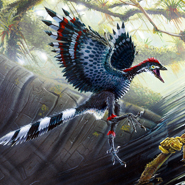Posted 18 May 2010
Prehistoric birds were poor flyers, research shows
The earliest known ‘dinobirds’, Archaeopteryx (145 million years ago) and Confuciusornis (120 million years ago), were incapable of vigorous flapping flight, according to new research published in the leading scientific journal Science.
Researchers at University College Dublin and the University of Manchester conducted a series of biomechanical tests on the feathers and wings of these ancient feathered dinosaurs to calculate the load bearing forces they would have had to withstand to support flight.
Pictured far right: Image courtesy of Todd Marshall
Both dinosaur fossils had primary feathers with extremely narrow central stems for their body size and feather lengths. According to the researchers, the much thinner central stem (rachis) of the dinosaur feathers must have been solid or they would have broken under the lift forces generated during flight or by gusts of wind. This solid structure is very different to modern birds, whose rachises are broader, hollow straws.
“It is impossible to tell from fossils whether the rachises were solid or hollow,” says Dr Robert L Nudds from the University of Manchester, the principal author of the research paper. “But I believe the dinosaurs’ feathers were solid and therefore they could fly, but very poorly. They would have been incapable of flight unless there feathers were of a fundamentally different structure to those of living birds.”
“Our findings suggest that Archaeopteryx and Confuciusornis were not capable of vigorous flapping flight, rapid turns or fast ascents, rather they were soarers or gliders,” explains Dr Gareth Dyke from the UCD School of Biology and Environmental Science, University College Dublin.
“The superficial resemblance of these ancient bird wing feathers to those of modern birds should not necessarily be taken as an indication of their ability to withstand the same aerodynamic forces,” says Dr Nudds.
With feathers structurally similar to modern birds, Archaeopteryx and Confuciusornis would only have been capable of parachuting with their wings raised and held dorsally to provide drag to reduce their descent speed, whilst reducing the forces upon their primaries, the researchers claim.
These findings have important implications for interpreting the behaviour of feathered early birds and proto-birds, and understanding the evolution of flight.
“Our analysis also shows that Confuciusornis, which is younger by 25 million years, was worse at flying than Archaeopteryx. This raises the further question of lineage – did the dinosaur-bird line branch off, giving rise to flying and flightless birds?” adds Dr Nudds.
This research builds on previous research published by Dr Nudds and Dr Dykes in the journal Evolution which investigated how the movement of feathered dinosaur forelimbs evolved into flapping flight.
(Produced by UCD University Relations)

